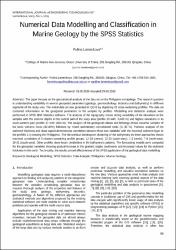Numerical Data Modelling and Classification in Marine Geology by the SPSS Statistics
Özet
The paper focuses on the geostatistical analysis of the data set on the Philippine archipelago. The research question is understanding variability in several geospatial parameters (geology, geomorphology, tectonics and bathymetry) in different segments of the study area. The initial data set was generated in QGIS by digitizing 25 cross-sectioning profiles. The data set contained information on the geospatial parameters in the samples by profiles. Modelling and statistical analysis were performed in SPSS IBM Statistics software. The analysis of the topography shows strong variability of the elevations in the samples with the extreme depths in the central part of the study area (profile 13 with -9,400 m) and highest elevations in its south-western part (profile 17 with 1950 m). The analysis of the geological classes and lithology shows maximal samples of the basic volcanic rocks (40,40%) followed by mixed sedimentary consolidated rocks (31,90 %). Pairwise analysis of the sediment thickness and slope aspect demonstrates correlation between these two variables with the maximal sediment layer in the profiles 1-4 crossing the Philippines. The hierarchical dendrogram clustering of the bathymetry by three approaches shown maximal correlation of 5 clusters containing profile groups: 12-18 (centre), 22-25 (south-west), 1-2 (north), 7-8 (north-east), 19-21 (south-west). Other profiles show lesser similarities in the bathymetric patterns. The forecasting models were computed for the geospatial variables showing gradual increase in the gradient angles southwards and increased values for the sediment thickness in the north. Technically, the results proved effectiveness of the SPSS application of the geological data modelling.
Cilt
5Sayı
2Bağlantı
https://hdl.handle.net/11363/1396Koleksiyonlar
Aşağıdaki lisans dosyası bu öğe ile ilişkilidir:


















